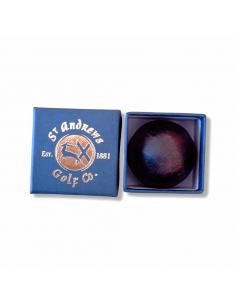Gutta Percha Hammered Golf Ball c1860
The Gutta Percha Hammered Golf Ball, introduced around 1860, was a significant step forward in golf ball design. Made from the resin of the Sapodilla tree, native to Malaysia, the Gutta Percha ball opened the game of golf to a wider audience. Its durability and affordability revolutionized the sport. As the second stage in the evolution of the Gutta Percha ball, the Hammered Ball featured a scratched surface, unlike the smooth version from the 1840s. Players noticed that the markings on the ball improved its flight performance, leading to the creation of this "hammered" design. This innovation paved the way for the Bramble Ball (c.1890) with its dimpled surface, which influenced the design of today’s modern golf balls.
Dr Robert Paterson invented the Gutta Percha ball in 1845. He found some chunks of rubber in his luggage from India, and he used them to make a golf ball. He found that this rubber could be readily moulded, and it was hard and durable.
The Gutta Percha ball was the first major development in the evolution of the golf ball as it made golf attainable for the masses. The ball was made from the resin of the Sapodilla tree indigenous to Malaysia and originally imported for use in dentistry. When heated in hot water, the resin was found to become very soft and easy to shape.
Later balls also had patterns that could affect the flight of the ball. The modern ball has a dimple pattern which was a follow on from the Gutta Percha period. The Bramble version was the version that most resembles modern dimple patterns. This ball is a close resemblance to an authentic Gutta Percha and is playable. Handmade in St Andrews, Scotland









